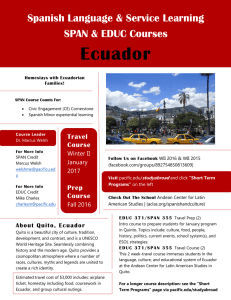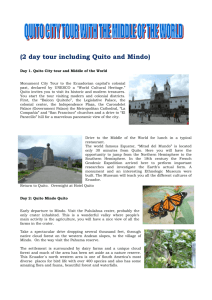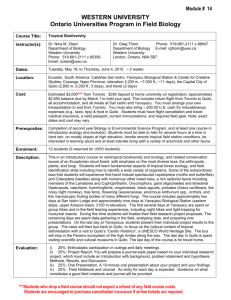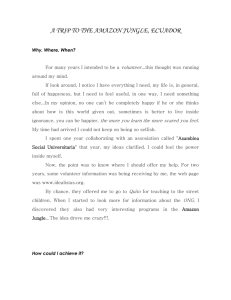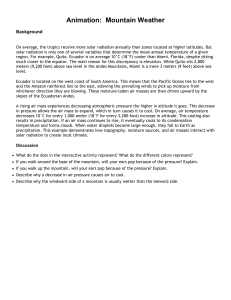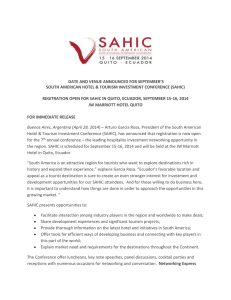! "#$%&'()!#*+$,#'*+! "-.!/011.234!56!2-.!781.!"95:3;81!#.<509;.<!&4<23202.!
advertisement
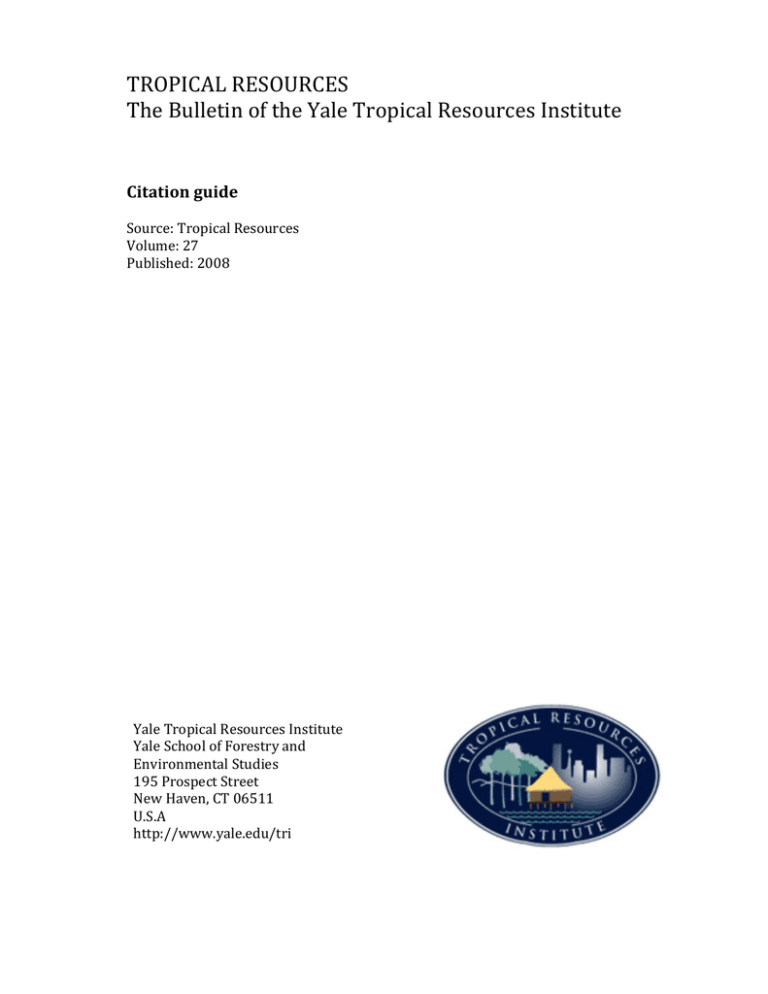
! ! "#$%&'()!#*+$,#'*+! "-.!/011.234!56!2-.!781.!"95:3;81!#.<509;.<!&4<23202.! ! ! ! ! "#$%$#&'!()#*+! ! +509;.L!"95:3;81!#.<509;.<! N510A.L!OP! %0Q13<-.?L!OIIR! ! ! ! ! ! ! ! ! ! 781.!"95:3;81!#.<509;.<!&4<23202.! 781.!+;-551!56!=59.<29>!84?!! *4@3954A.4281!+20?3.<! BCD!%95<:.;2!+29..2! E.F!G8@.4H!'"!IJDBB! ,K+K(! -22:LMMFFFK>81.K.?0M293!! ! ! ! ! ! ! ! ! Urban Growth in Peri-urban Quito, Ecuador: Challenges and Opportunities for Comprehensive Land Use Management by Brenna Vredeveld, MESc 2008 Introduction Quito, Ecuador has been a cultural, economic, trading and population center for centuries. Recently, rapid urban expansion has shaped its region. Located at 2800 to 3200 meters above sea level, it now measures forty to fifty kilometers long and five to ten kilometers wide, unfolding along the trough-shaped inter-Andean valley in which it lies (Carrión 2005, Riaño 2001). From 1950 to 1990 the city grew six-fold in population and twenty-fold in area systematically incorporating minor urban areas on the periphery (Pitkin 1997, Riaño 2001) (Table 1). Unsuccessful attempts to regulate this growth have included urban growth boundaries and decentralization of management powers (Ramírez, pers. comm. July 2007). In particular, the valleys to the south and the plains to the east of Quito have experienced heightened impacts of urbanization given their greater capacity to provide livelihoods and jobs (Murray 1997). This growth has consumed fertile agricultural lands and natural areas, which in turn has prompted the agricultural frontier to expand outward into protected páramo (highland grassland) and native forests. The result has been an increasing Brenna Vredeveld, originally from the southeast US, holds a BA in Environmental Studies from Wellesley College. Before beginning her master’s studies at Yale, she worked in both Southern California and Mexico City in issues involving management of periurban lands. She has lived and traveled extensively in Latin America. In her future career, she hopes to continue work with land use management around urban areas in conjunction with water resources conservation. strain upon disappearing natural resources (De Bievre et al. 2007a,b). At the peri-urban interface, where land transitions from urban to rural, the composition of people and landscapes remains dynamic, metamorphosing as economies, populations and environments evolve (Adell 1999, Allen 2003, Douglas 2006). It is here that overlapping national, provincial and local land management institutions greatly influence the changing land uses of this region. And as the city grows into these areas, as infrastructure and populations solidify across municipal boundaries, opportunities for more synergistic approaches to urban growth management present themselves. I came seeking to examine Quito’s periurban growth management at local, provincial and national levels. Through this multi-scale approach, I found that communities, municipalities and national ministries each play a significant role in influencing urban growth in this region. Yet, there remain many collaborative opportunities that these diverse actors can take advantage of in order to comprehensively manage the associated land transition processes. Site description and history I concentrated on land use management and planning in three peri-urban communities in two cantones (counties)—Mejía and Rumiñahui—to the south and southeast of Quito (Figure 1). These communities represent a gradient of urban development and were chosen to better understand their integration and participation in the urban growth management process. El Chaupi in Cantón Mejía is the farthest from Quito; Tropical Resources Bulletin 79 Brenna Vredeveld Table 1. Population projections of Quito, Mejía and Rumiñahui and percent urban population. Population (# of inhabitants) Percent Urban Area (km2) 2001 2007 2025 Population (2001) Quito (urban) 1,856,555 2,180,000 2,828,363 90.28% 4,204.55 Quito (rural) 315,713 384,077 593,766 Mejía 61,246 71,862 116,083 48.38% 1,459.23 Rumiñahui 65,882 79,558 140,307 88.71% 134.15 Sources: De la Torre 2004, De Bievre and Coello 2007a, Strategic Plan of Rumiñahui, Stategic Plan of Development of Mejía it has the slowest rate of population growth and expansion of urban infrastructure. It is the most rural in nature with an economy and population that depend on agriculture and cattle ranching. Cutuglagua, a fast-growing sector closest to Quito, is economically and infrastructurally merging with the city even though it lies within Cantón Mejía. Its population is largely composed of migrants from rural provinces who have come in search of employment, education and to benefit from its proximity to a large urban center. San Fernando, in Cantón Rumiñahui, is experiencing moderate growth due to its milder climate and lower population density, which attracts a mix of rural migrants and those wishing to leave Quito. Within each community, I focused on either a single water user group (El Chaupi and Cutuglagua) or a community association (San Fernando).These communities and cantones are located within important sub-watersheds, which supply water to Quito—those of the San Pedro and Pita Rivers. Figure 1. The Quito region lies in the Pichincha Province of Ecuador, in the Andes Mountains. Urban expansion of the city has begun to extend into neighboring cantones (counties) of Mejía and Rumiñahui to the south and southeast. Specific study sites—Cutuglagua, El Chaupi and San Fernando—were chosen to represent a gradient of urban development. 80 Volume 27, Spring 2008 Urban Growth in Peri-urban Quito, Ecuador Figure 2. Agencies at provincial and national levels influence both urban and rural land use management in the Quito region either through direct regulation or collaboration. At a provincial or cantonal level, collaboration between agencies is often unidirectional. At the national level they do not collaborate outside of projects at provincial or cantonal levels. Arrows indicate the direction of influence in relationships between agencies and the use and development of urban or rural land. Solid lines reflect existing relationships; dotted lines reflect those that exist only on paper or are anticipated in the future. Methods I conducted semi-structured interviews with organizations at three scales—local, provincial and national—to determine their roles in the land use planning process and the nature and extent of their collaboration with other institutions. At the local level I spoke with community leaders. At the provincial level, I concentrated on government agencies in charge of land use and natural resources planning and regulation such as the Departments of Planning and the Environment of the Metropolitan District of Quito (DMQ), Mejía and Rumiñahui and the Government of Pichincha. The national level included ministry programs for managing agriculture, natural resources, community development and housing. I completed a total of 23 interviews, conducted in Spanish with the help of an Ecuadorian assistant. I supplemented these with information from the Development Plans of relevant local and provincial governments and institutional documents from the ministries. Results and discussion Management agencies, local governments and communities recognize that urban growth in these peri-urban regions has been occurring at an uncontrolled pace. Most describe its negative impacts on water quality and availability, the unsatisfied needs for better infrastructure that it generates, the associated increases in population and traffic congestion and the decreasing number of green and natural spaces. Among the reasons they cite for these trends are rapid migration, lack of appropriate zoning in urbanizing areas, corruption of management officials and lack of economic resources. Not mentioned very often is the lack of meaningful collaboration among land management and planning institutions (Figure 2). Tropical Resources Bulletin 81 Brenna Vredeveld Participatory planning at the local level Communities in El Chaupi, Cutuglagua and San Fernando participate in planning processes through community organizations and representative local government. They express their goals in terms of improvements in infrastructure, health, education and the economy, as opposed to specific land uses. Though, if government is slow to provide needed services, they often take the initiative themselves, regardless of the land use regulations, for which monitoring and enforcement are generally weak. Unlike El Chaupi and San Fernando, Cutuglagua’s constantly changing and expanding demographic makes broad community participation in such initiatives more challenging. In all three communities, specific household land uses are allowed to continue so long as they do not create conflicts with other community members. In addition, separation of planning responsibilities between cantonal and provincial governments occurs throughout the region. Because Cutuglagua and San Fernando are classified as “urban”, their goals are incorporated into the Plans of Development of Cantón Mejía and Cantón Rumiñahui, respectively. El Chaupi, on the other hand, is considered rural and collaborates exclusively with the Provincial Govern- ment of Pichincha. This separation is reflected in Mejía’s Plan of Development, which focuses on its urban areas. Rumiñahui gives a more comprehensive (though not complete) treatment to its rural and urban areas most likely because it has more resources to train planners and land managers and to prepare comprehensive planning documents. Collaboration among planning institutions: DMQ, Mejía, Rumiñahui and Pichincha The management strategies that the DMQ adopts often dominate regional planning. Its creation in 1992 granted it more substantial legal authority to regulate its own growth and natural resources. Greater economic resources allow the District to employ a larger staff of trained personnel to use sophisticated technologies for such management. They have attempted to direct growth towards certain sectors by providing affordable housing and improved transportation corridors, but their weak enforcement of land use regulations (i.e., legalizing illegal settlements) has resulted in spontaneous growth to many areas, even onto lands designated as non-urbanizable or protected (Valdivieso 2005, Bermúdez, pers. comm. July 2007). Mejía and Rumiñahui, operating on smaller budgets and Photograph 1. La minga, or “community service”, is a cornerstone in rural areas of Ecuador in which communities work together to construct sanitation systems, build houses, improve community green spaces, etc. In Barrio San Fernando—adjacent to a rapidly expanding urban area southeast of Quito—the community builds trails and cleans a small stream as part of an ecotourism project in an abandoned nearby valley. 82 Volume 27, Spring 2008 Urban Growth in Peri-urban Quito, Ecuador with fewer staff, have been forced into reactive planning approaches as they are subject to the side-effects of population overflow from Quito. For Mejía and Rumiñahui, external assistance with planning initiatives has been a great help in sharing costs and saving time. They have adopted convenios de mancomunidad or “community agreements”—informal contracts that maintain working relationships—with other institutions and municipalities in this region to facilitate information sharing and collaboration, in this case to direct growth that spans municipal borders and lend technical assistance. Mejía’s new Department of Planning has requested help from the DMQ’s Planning Department to create zoning plans to regulate growth in urban and urbanizing communities (Cajiao, pers. comm. August 2007). Rumiñahui, similarly, has turned to the Association of Ecuadorian Municipalities (AME) to help structure its Plan of Development and Zoning (Ramírez, pers. comm. July 2007). Decentralization of land management powers to local authorities allows these three cantones to better respond to their community’s needs. While their Plans are also developed to comply with the new Plan of Development for the Pichincha Province, it has yet to be seen if they do so in practice. Collaboration among the municipalities remains on a level of lending technical assistance and resources rather than coordinating and complementing planning strategies. Integrating their planning policies could be particularly beneficial for managing watersheds and natural resources (e.g. native forests, páramo), which do not respect political boundaries. No mention of this kind of collaboration between Mejía and Rumiñahui was made in any of the interviews. Collaboration among planning institutions and others National organizations such as the Ministry of Agriculture (MAG), the Ministry of Urban Development and Housing (MIDUVI), the As- sociation of Ecuadorian Municipalities (AME) and the Ministry of the Environment provide assistance to local and provincial governments for land use management only when requested to do so. The local government defines the roles and extent of the agency’s participation, which reinforces the separated treatment of urban and rural planning. Outside of providing assistance to the municipalities there is little collaboration among these national organizations to define long-term, comprehensive land use planning strategies. Narrowly defined roles as normative regulators and “community agreement” facilitators also restrict these national agencies from participating directly in cantonal and provincial land management and urban growth plans. They are consultants rather than participants. This approach helps to maintain the integrity of projects in responding to local needs, but limits the creative planning capabilities that these agencies can apply to such projects. The combination of limited participation and resources has resulted in a lack of programs for those rural and natural areas that face increasing pressures of urbanization. The MAG, for example, has no robust programs to help farmers resist urban expansion pressures; it offers only limited technical assistance programs to small-scale agriculturalists. Its hopes for more direct participation count on only recent changes in agricultural policy (Velásquez, pers. comm. July 2007). Other than operating limited community development programs, the MIDUVI remains restricted to revising legal aspects of development projects. In the Pichincha province these Ministries work exclusively in the cantones outside of Quito, respecting the DMQ’s special legal authority to manage its own land and public services. Many of these national agencies hope that a new Ecuadorian constitution, currently being written, will empower them to participate beyond their normative capacities in order to better contribute to land management initiatives in their respective areas of expertise. Tropical Resources Bulletin 83 Brenna Vredeveld Photograph 2. A view of Quito looking east from the sides of Volcano Pichincha. Unfolding along an inter-andean valley, the city measures 40-50 km long and 5-10 km wide. El Valle de los Chillos, just over the eastern ridge, is home to recent urban expansion in this region. Conclusion The multi-scale, urban-gradient approach of my research identified several challenges that hinder effective urban growth management. In general, there is a lack of effective and comprehensive collaboration across institutions at all scales. “Community agreements” are limited to technical assistance programs when the real need is for coordinating and complementing development plans across administrative boundaries. Similarly, there is an absence of coordination among institutions that work on both the urban and rural sides of the expanding peri-urban interface, including within cantonal planning departments. The separated treatment of urban and rural spaces often leads to favoring urban planning in these peri-urban areas, to the detriment of rural and natural areas. This entrenched rhetoric reinforces itself by dictating the participation of national institutions in planning processes. While these national institutions may have many hopes for more direct participation, their limited scope relegates them 84 Volume 27, Spring 2008 to waiting for appropriate political changes to make it possible. In addition, the centralization of planning resources in Quito allows it to dominate regional planning policy, forcing Mejía and Rumiñahui into reactive planning approaches. Organizations across all scales suffer from an inability to effectively enforce the regulations that they create. Keeping up with the pace of city expansion spreads their time, money and staff thin. Confronting these challenges could be captured within a long-term, comprehensive land use plan that takes into consideration the flows of people, resources and markets between urban and rural spaces at the peri-urban interface. Such a plan could integrate resources and responsibilities across institutions at the various scales, regardless of political-administrative boundaries. This process also creates opportunities to engage local actors—the land use decision-makers that are expanding the periurban interface on a daily basis—through the established non-governmental and community organizations with which they work. While I Urban Growth in Peri-urban Quito, Ecuador did not focus on them in this study, their presence in on-the-ground land use management in this region is very real. Their ability to be a collaborative intermediary between communities and planning institutions is promising, though depends on community strength and demographic turnover. With such foundations, next steps could include resource sharing that focuses on addressing urban growth processes such as rural to urban migration, low profitability of small-scale agriculture that makes it susceptible to urbanization pressures and poor quality of life in both urban and rural areas. Using these new targets to capitalize on creative planning capacities of more participatory national ministries could then become a goal. Overall, the relationships between these diverse groups and their willingness to collaborate are as important as the projects and plans they develop. Regulating the rapid growth of this “mancha urbana” (literally the “urban stain”) calls for them to take advantage of these collaborative opportunities, leaving behind the political, institutional and urban or rural biases that now separate them. Acknowledgements Thanks to the Tropical Resources Institute, the Program in Agrarian Studies, the Hixon Center for Urban Ecology, and the Council on Latin American and Iberian Studies for their financial support. I am greatly indebted to el Fondo para la Protección del Agua (FONAG) for their on-the-ground support and expertise, especially Jacqueline Cisneros, Pablo Lloret and María José and Andrés. A special thanks to Alejandra Repetto who was an invaluable research assistant. Thank you to Santiago and Bárbara Vallejo who welcomed me into their home in Quito. Finally, were it not for the support of my friends and colleagues at the School of Forestry and Environmental Studies, including my advisors Bill Burch and Lisa Curran, I could not have accomplished so much. References Adell, G. 1999. Literature Review: Theories and models of the peri-urban interface: a changing conceptual landscape. Development Planning Unit, University College London. Allen, A. 2003. Environmental planning and management of the peri-urban interface: perspectives on an emerging field. Environmental Planning and Management 5: 135-148. Bermúdez, Nury. Department of Planning of the Metropolitan District of Quito. Personal communication. July 19, 2007. Cajiao, Augusto. Director of Department of Planning of Cantón Mejía. Personal communication. August 1, 2007. Carrión, D. 2005. Dealing with illicit construction in Quito. Paper prepared for EMI Thematic Session Root Causes of vulnerability of human Settlements in Megacities, World Conference on Disaster Reduction, Kobe, Japan 20 January 2005. De Bievre, B. and X. Coello. 2007a. Caracterización de la Demanda Hídrica: Manejo Integrado de los Recursos Hídricos en la Hoya de Quito. UICNSUR, Quito, Ecuador. De Bievre, B. and X. Coello. 2007b. Caracterización de la Oferta Hídrica: Manejo Integrado de los Recursos Hídricos en la Hoya de Quito. UICNSUR, Quito, Ecuador. De la Torre, L. 2004. Plan Maestro Orientador del Manjeo de los Recursos Hídricos en la Hoya de Quito. The Nature Conservancy, Quito, Ecuador. Douglas, I. 2006. Peri-urban ecosystems and societies: Transitional zones and contrasting values. In D. McGregor, D. Simon and D. Thompson (Eds.), The Peri-urban Interface: Approaches to Sustainable Natural and Human Resource Use, pp.18-29. London: Earthscan. Murray, S. 1997. The Quito context. In S. Murray, Urban and Peri-urban Forestry in Quito, Ecuador: a Case-Study. Rome: Forestry Department, Food and Agriculture Organization of the United Nations. Tropical Resources Bulletin 85 Brenna Vredeveld Pitkin, B. 1997. The urban environment and participatory planning in Quito’s barrios populares. UCLA Advanced Policy Institute, School of Public Policy and Social Research, University of California Los Angeles. Presented at Association of Collegiate Schools of Planning Conference, 7 November 1997. Ramírez, Gustavo Rubio. Director of Department of Planning of Cantón Rumiñahui. Personal communication. July 18, 2007. Riaño, Y. 2001. Informal land use in peripheral barrios in Quito: Planning problem, development obstacle or poverty alleviation? Paper presented for the N-AERUS Workshop Coping with informality and illegality in human settlements in developing countries, Leuven, May 2001. Valdivieso, J.M. 2005. Propuesta para la gestión integral del suelo no urbanizable del Distrito Metropolitano de Quito. Programa de Saneamiento Ambiental para El Distrito Metropolitano de Quito (PSA). Quito, Ecuador. Velásquez, Hernán. Director of the System of Geographic Information for the Agricultural Sector, Ministry of Agriculture (SIGAGRO-MAG). Personal communication. August 7, 2007. Source: http://www.oldbookillustrations.com/index.php?lng=en 86 Volume 27, Spring 2008
